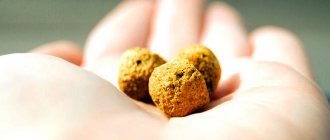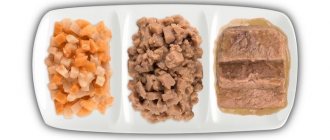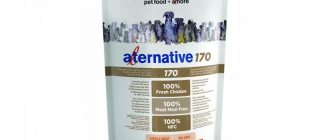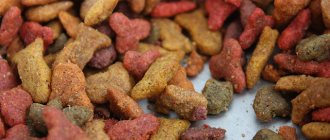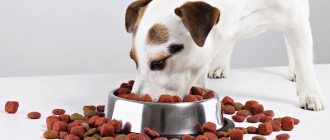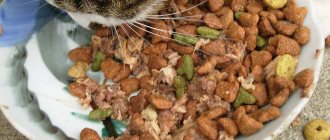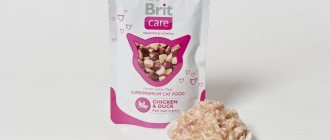For many specialists, as well as for dog and cat owners, the division of industrial food into classes is an immutable truth. They believe that since “super premium” is written on a package of food, this automatically guarantees decent quality ingredients, high digestibility and availability of nutrients, and if the word “holistic” is included in the description of the diet, then such a product is absolutely excellent in quality and composition, and is perfect for a pet.
Unfortunately, this is often only the perception of consumers, imposed by the competent actions of marketers, sales agents and “ambassadors” of a particular brand.
The principle of “divide and conquer”
The idea that some classes of food are better than others has firmly taken root in the minds of consumers, and we realized that it is high time to talk about what types of food there are, or rather, what the classification of animal food is in detail and frankly.
We would like to clarify some important points and help you avoid falling for the marketing scams of manufacturers and sellers.
The need to classify dry food arose among manufacturers of ready-made diets when the feed industry began to actively develop. New, more expensive diets appeared, and the question arose of how manufacturers could promote such foods and win the attention of consumers. After all, each manufacturer was not averse to presenting the advantages of their product as best as possible and highlighting the disadvantages of competitors.
Also, the classification of feed into classes is useful for large concerns that produce feed products in different price categories for different groups of consumers - this makes it easier for them to explain the differences between their many brands.
Feed classification is outside the law
You should know that there is no officially accepted industry or any other legal classification of feed quality. Accordingly, there are simply no officially established standards and requirements, confirmed by scientific research, that diets must meet in order to be classified in one or another of the classes.
Rather, the process goes, so to speak, in reverse - this market-imposed gradation of feeds forces interested parties to identify the key distinguishing features of each class in order to understand how the feeds differ.
The current classification can be called the joint “oral creativity” of producers, sellers and buyers. Everyone, at their own discretion and depending on their own benefits or interests, classifies ready-made food as they want.
Class boundaries cannot be determined
We are faced with the fact that a lot of information about the classification of feed available to a wide audience, especially on the Internet, looks reasonable and clear at first glance, but is essentially a figment of the imagination of supporters of one class or another.
You should not believe those who write that “super premium” feed uses the highest quality raw materials, and “economy” feed uses the worst. No matter how much one would like to believe it, everything is far from so simple. There are no clear gradations, for example, between “economy” and “premium”, “premium” and “superpremium”, “superpremium” and “ultrapremium” feeds.
“Feed your pet correctly”: our classification of food
Since at the moment the spontaneous classification of feeds and their characteristics have become very firmly established among consumers, we decided to combine our own knowledge and experience in diet analytics, as well as data from foreign sources, and bring to your attention a summary table of the characteristic features of ready-made complete feeds with additional explanations of the features of each from classes.
Please note that we give all names of feed classes in quotation marks, since these are just names that are not terms.
Below are the characteristics of ready-made food for dogs and cats according to the “Feed Your Pet Correctly” version. You can determine what class of food you have on hand based on these criteria.
| Feed classes | ||||||
| Economy | Premium | Superpremium | Ultrapremium | Holistic superpremium | Biologically relevant | |
| Feed class in the name | ||||||
| The names are attractive, the emphasis is on taste! The words “delicious”, “appetizing”, “fragrant” are often used. | Names often contain information about the age or condition of the animal; less often they are informationally attractive. | The names are often more information-attractive and the emphasis is on the ingredients. | ||||
| Feed class on packaging | ||||||
| The packages are bright, they show photos of happy, cheerful animals. Photos of colored granules are often included. | The packaging is different, often bright and attractive. | The packaging is often bright, with images of purebred animals. | The packaging design usually uses a natural range of shades, but there are also bright, attractive photos of ingredients and views of nature. The animals themselves are sometimes depicted schematically. | |||
| Health icons on packaging | ||||||
| They are present very rarely and without details, all explanations are given in general terms. | Usually present, the packaging provides either general comments or detailed explanations of how the ingredients “work.” | |||||
| Features of feed formulas | ||||||
| Characterized by free formulas, the components in the composition may vary from batch to batch. | Fixed or conditionally free formulas are typical (they may contain ingredients named in groups, but not in such general terms as in “economy” feeds). | Characterized by fixed formulas, the ingredients cannot change depending on the prices of raw materials. | ||||
| Presence of ingredients named by groups | ||||||
| A lot of them. In the composition you can find “meat and offal”, “fish”, “cereals”, etc. | They do occur, but their proportion is different. If such ingredients exist, then the formula cannot be considered fixed. | No | ||||
| Features of ingredient No. 1 | ||||||
| Usually these are mixtures of different components. It is impossible to understand exactly what is contained in them. | Cereal, rarely a meat component. | Mostly meat component | ||||
| Availability of fresh meat and fish | ||||||
| No | Rarely, most often not | More often there is | Eat | |||
| Availability of useful supplements | ||||||
| No | Rarely, most often not | There are, for example, prebiotics, chondroprotectors, and substances for protecting teeth. | Many different additives, including phyto-components. | |||
| Presence of artificial colors and preservatives | ||||||
| Often | Rarely | More often than not | No | |||
| Presence of natural preservatives (tocopherols, rosemary) | ||||||
| No | More often there is | There are, or are used, other natural sources of antioxidants. | ||||
| Sales points | ||||||
| Tents, convenience stores, supermarkets, sometimes pet stores, online trading. | Large supermarkets, pet stores, online trading. | Specialized pet stores, veterinary clinics, rarely supermarkets, online trading. | Specialized pet stores, veterinary clinics, online trading. | Specialized pet stores, online trade. | Specialized pet stores, online trade. | |
Rating of the best dry food for puppies
The rating presents the best food for young dogs, according to veterinary experts and owners. Despite the fact that economy class food is not suitable for constant feeding of a puppy, we suggest considering ready-made diets for young dogs in this category.
Food for small breed puppies
Puppies of small decorative breeds grow faster than their relatives, who grow into giants. You should definitely choose food that has a mark on it - for puppies of small breeds. In addition, some manufacturers offer puppy diets divided by breed. For example, there are diets for Yorkshire terriers, French bulldogs, etc.
Bosch
The food belongs to the super-premium segment. The diet is based on chicken meat (about 26%). Rice and millet are the most gentle ingredients for the puppy’s stomach as a source of carbohydrates. The food granules are adapted to the size of the baby's mouth, and the special (not too dry) structure does not injure the delicate mucous membrane.
The food formula contains an increased percentage of fatty acids, which have a positive effect not only on the appearance, but also on the intellectual development of the dog.
The disadvantage of the food is the presence of components that can cause allergies.
ROYAL CANIN Size Mini Starter
Royal Canin Starter food is suitable not only for small breed puppies, but also for pregnant (nursing) bitches. A special feature of the ready-made diet is that it is intended for the little ones - you can start feeding the puppy with it from the moment it is weaned from its mother. The food formula is supplemented with special nutrients that will not cause harm to the baby’s gastrointestinal tract. The granules are easily soaked in water and have an attractive taste. They help the baby’s gastrointestinal tract painlessly transition from milk to porridge, and then granules.
Royal Canin dog food – reviews and analysis of the line
TRAINER Fitness (duck, rice)
Italian food intended for feeding dogs aged 3 months to one year. It is a complete monoprotein nutrition. The composition is based on: freeze-dried duck meat (20%) and rice (35%). Suitable for dogs prone to food allergies. Contains a special mix of herbs, roots and the patented Echinacea complex to protect the dog's growing body and activate immune processes.
Hill's Science Plan Puppy Small & Mini (chicken)
Special small granules contain:
- docosahexaenoic acid - for the development of the dog's brain;
- high-quality protein for muscle development;
- minerals for bone strength;
- a mixture of natural antioxidants.
Hill's dog food - complete review of the line
Food for medium breed puppies
Food for dogs that grow up to weigh 25-27 kg. These include Labrador, German Shepherd, Bull Terrier, English Bulldog, Husky, etc.
Monge (Puppy and junior)
Italian food Monge is suitable for puppies and young dogs. Suitable for animals from 2 months to 1 year. There are three flavors in the line for your pet to choose from: chicken, salmon, and lamb. Advantages:
- first place for meat ingredients - about 30% dehydrated meat and about 12% fresh;
- carbohydrates are represented by rice, beets and oats;
- rich vitamin supplement.
Cons : contains corn.
Monge food for dogs - reviews from veterinarians and a detailed analysis of the line
Eukanuba medium breed
The food is produced in the USA, Russia, and Holland. The composition practically does not change depending on whether the puppy is a small, medium or large breed. The choice of flavors includes chicken, rice and lamb. Carbohydrates are represented by corn, rice, and wheat. Rich vitamin component. The meat content reaches 35%. One of the disadvantages of the composition is the presence of corn, which can cause allergies in the baby.
Eukanuba dog food - reviews and composition analysis
SIRIUS for puppies and young dogs
The product from the Russian company is suitable for any puppies and young dogs under 12 months. Sirius brand food contains: pectin complex, chamomile, echinacea, dried cranberries, Yucca Schidigera. Only natural antioxidants are used. Ingredients: dehydrated meat 29% poultry and 8% lamb, rice, wheat, corn, dietary fiber, dry yeast, salmon fat, special ProStor Bio Care complex.
Sirius dog food – advantages and disadvantages, reviews from veterinarians
Brit Care Puppy (grain-free)
Grain-free food for puppies of all breeds with salmon and potatoes. The product does not contain chemical ingredients, GMOs or hormones. A daily portion of food satisfies all the needs of a young dog for vitamins and minerals. The pleasant aroma of salmon oil attracts even the most demanding animals with its natural aroma. The absence of grains allows the food to be quickly absorbed and does not cause bloating and flatulence. In addition, the product is suitable for puppies prone to allergies.
Brit dog food - expert reviews and detailed analysis of the composition
Food for large breed puppies
Food for puppies of such giants as Cane Corso, St. Bernard, Alabai, etc.
Grandorf
Holistic from Belgium is presented in two versions: from 3 weeks of age and from 4 months. It is based on lamb and rice, turkey. The meat component reaches 60%, because protein is so important for large dogs during the period of active growth. The carbohydrate component is rice and a complex of dried fruits. There are no synthetic additives or GMOs in the composition.
Grandorf dog food - full review of the line and reviews from experts
Acana Puppy and Junior
Akana dog food from Canada is suitable for puppies of all breeds. Contains 30% dehydrated meat (this can be turkey, chicken, lamb) and 10% bone meal. The peculiarity of Akana is its complex of dried vegetables, fruits and berries. In addition, it contains whole eggs, herring and flounder.
Akana dog food - full review of the line
Go
Gou is another holistic practitioner from Canada. The product is suitable for both puppies and adult dogs. The special feature is an interesting composition, including 4 types of meat, poultry, oatmeal flakes, and salmon. In addition, it contains dried vegetables, fruits and berries. The protein component reaches 60%.
Dog food GO!: analysis of ingredients, reviews from owners and veterinary specialists
Pedigree
Economy food from an American manufacturer. The puppy line starts at 6 months of age. It is from six months that the baby will be able to digest the amount of fiber that is named in the composition - more than 50%. And only 15% is protein. Nevertheless, the manufacturer is constantly among the sales leaders, since its food is available in any supermarket.
Dog food Pedigri - analysis of the recipe, reviews from owners and veterinarians
Economy class
Unlike other classes, you will not find the word “economy” on bags of dog and cat food - it is not in the interests of manufacturers to place it there. The very name of this huge group of products suggests that they are designed for those buyers who are not very picky about the quality of diet for a dog or cat, do not go into details of the composition and want to save money.
Such diets are indeed cheaper than all other options for ready-made food, since they use far from the best raw materials. At the same time, the names of such products mostly try to convince buyers that the diets are very tasty and will appeal to their pets.
Formally, economy-class food contains all the nutrients an animal needs, and the data on protein and fat on the labels in the “Analysis” section meets the standards. These diets are considered balanced, as they contain all the necessary vitamin and mineral supplements.
How to understand that this is an “economy”
A characteristic feature of economy feeds are images of multi-colored granules on the packaging, but if there is no such picture, then this does not mean anything. The main feature of the compositions of this category of food is that almost all the ingredients in the list are indicated in broad groups.
This always indicates the lack of transparency of information about the composition and the fact that the quality of raw materials is not a priority for the manufacturers of these feeds. The formula, that is, the actual composition of the “economy feed” raw materials, can change from batch to batch, in accordance with fluctuations in the prices of the components, which is why it is called free, or non-fixed.
Pets are usually very willing to eat such diets, ask for supplements, and then may refuse higher-quality ready-made food, since the raw materials for such diets may contain various flavoring additives. Such foods are usually not divided by age (at best, there are two options - for kittens/puppies and for adult animals), breeds, or physical condition, but they are often divided by taste.
"Economy" - the most popular and advertised
Many large supermarkets now sell a variety of products, including ready-made animal food, which is produced under the name of the retail chain itself or under their own brand. Most of these ready-made feeds belong to the “economy” class.
It’s sad that it is “economy class” food that attracts buyers by the appearance of its packaging, and they are most often advertised on TV. It is not surprising that the advertising of these brands is truly professional, “tasty” and attractive - huge amounts of money are spent on it, the best agencies work on it. It touches the best feelings, and as a result, buyers automatically transfer the quality of advertising to the quality of the product.
The basic principles for assessing the quality of feed should be clear, clear and exclude any compromises or concessions. We strive to teach you to evaluate not advertising or attractive pictures on the package, but only the list of ingredients.
Economy products occupy a huge niche in the ready-made diet market, but unfortunately, we cannot recommend them as the best option for feeding pets.
Reviews from veterinarians
About natural nutrition:
Vladimir Mitin:
“Dogs love raw meat or fish. Cartilage and beef bones are suitable for strengthening tooth enamel.”
What foods do veterinarians recommend:
Olga Ivanchenko:
“Cheap brands will not provide the dog with adequate nutrition. I choose Canadian Pronature Holistic as a truly high-quality and complete product.”
Sergey Rudenko:
“The dog’s body reacts poorly to cheap food. Choose holistic or super premium class if it is not possible to feed your pet natural food. Among them there are both medicinal and specialized types.”
Here's what negative veterinarians say about dry food:
Ekaterina Chistova:
“A very questionable ingredient, dehydrated protein. The quality and origin of the product is unclear.”
Valentina Belova:
“Animals often suffer from low-quality food. Economy class food does not contain enough nutrients for a dog. I advise you not to skimp when choosing food.”
However, there is also an opposite point of view:
Ekaterina Nigova:
“Dehydrated protein is not suitable for breeds prone to allergic reactions to different types of food, since the exact composition is unknown. For others, there’s nothing particularly scary about this: animal proteins are good in any case as a source of protein.”
Premium class
It’s too early to rejoice if you see the inscription “premium quality” on the food label. You should not expect that “premium” ready-made food is as good in its own way as “luxury” high-quality premium brands of perfumes or clothing.
Premium food for dogs and cats has nothing to do with luxury or premium quality. In the finished feed market, this concept is greatly devalued. This is just a group of products that are CONDITIONALLY a little better and more expensive than “economy”, but worse than “super premium”.
The ingredients of “premium” diets are not so different from the composition of “economy class” products, but individual components of slightly better quality can be added to these feeds.
"Premium" ready-made foods are complete and balanced and, of course, are divided by taste, in addition to this they are usually divided by life stages and animal sizes. Sometimes among them there are products for animals with physiological conditions characteristic of dogs and cats - for example, intended for pets after castration and sterilization, or for those who are overweight.
What's in dry dog food?
Industrial feed is prepared from meat and offal; they are the most important components. All food can be divided into several classes (they will be discussed later in the article). And if pellets belonging to the super-premium or premium class most likely still contain meat, then to obtain the economy class, waste from meat processing plants is most often used, and this is not the healthiest food for a dog.
All packages must indicate the amount of protein, which can be of plant or animal origin. Meat is often replaced with the following products:
- meat, fish and bone meal;
- soy;
- feed yeast;
- various types of cakes.
Dry food must contain carbohydrates; they are obtained from grain (wheat, oats), bran, and vegetable juices. This component improves digestive processes and also helps balance nutrition.
Fats contribute to the palatability of the food itself. It is best if it is of animal origin, such as chicken or turkey. To obtain vegetable fat, corn grain or soybeans are used.
Vitamin and mineral complexes are included in premium or holistic feeds. Such supplements support the health of dogs, have a beneficial effect on the musculoskeletal system, and improve the functioning of the digestive system. If your pet eats only industrial types of food, then such additives must be included in its diet, the same applies to older animals.
“Gourmet” diets: taste or benefit?
Within the “economy” and “premium” options, we can distinguish “gourmet” or “gourmet diets” foods. Their name comes from the word “gourmet”, meaning the concepts of “gourmet” and “delicacy”. It is impossible to separate these foods into a separate class of diets, but it is worth talking about them, since the quality of the raw materials in them often does not at all correspond to the pompous names and laudatory statements from TV screens.
Such diets exist mainly in the form of canned food. There is a particularly large selection of similar products for cats. They benefit from their mouth-watering names and attractive food images on labels that appeal to the human perception of food.
Names are like menus
The names of “gourmet” diets often resemble dishes for people. They use the words "dinner", "roast", "stew" and the like. These foods are described very beautifully and attractively, almost like dishes in a good restaurant - with mention of sauces and gravies, simmering, stewing over low heat, the words “fragrant”, “tasty”, “tender”, diminutive names like “chicken”, “thighs”, or places or manufacturing technologies - “Catalan style”, “Oriental style”.
Usually their packages are small, for 1-2 meals, and their price is usually higher than the average cost of “economy” and “premium” food.
No matter how attractive the promises of these foods may be, we still urge you to pay attention to what is written in the fine print, namely, the actual composition of the products. Attractive labels and messages are designed to make owners salivate, but the ingredient list often falls short of high expectations.
There you can find the same general names for groups of components, including grains. Such vague components in no way correspond to the principles of haute cuisine or proper nutrition for cats and dogs.
Super premium class
“Super-premium” food is always divided not only according to taste, but also according to the size, age and physiological state of the animals. Sometimes this fragmentation intensifies, and food appears in the assortment intended for cats and dogs of different breeds - as a result, food lines “swell” to incredible sizes, and products of one brand can occupy 4-5 large shelves in a pet store.
Many of these brands have special lines of veterinary diets. The price of “super premium” class diets can vary greatly, but in general, they are significantly more expensive than “premium” foods. Some of these diets can be found on the shelves of large supermarkets, but more often they are sold in specialized pet stores and veterinary pharmacies.
The “super premium” level food is distinguished by the inclusion of special functional additives - for digestion, protection of joints, and the immune system. On the packaging you can find drawings and notes about the maintenance of various organs and systems of animals, the so-called “health claims” - “health statements”, indicating specific components or, so to speak, “in general terms”.
Preservatives in such foods can be either natural or synthetic, or a combination of one and the other.
The largest companies that produce “super premium” food traditionally distribute a lot of printed materials, conduct training for veterinarians and breeders, sponsor dog and cat shows, as well as veterinary conferences, carry out external and internal decoration for pet stores and veterinary clinics using their logos brands.
Smaller companies operating in the same segment strive to be like them, but they promote their products mainly via the Internet or through consultations at exhibitions.
The best foods for small breed dogs
Belcando Finest Light for older or overweight dogs
The product is manufactured by a German company. It is distinguished by the use of excellent raw materials. Suitable for feeding the most fastidious small pets who are prone to gaining extra pounds. It consists exclusively of natural ingredients of excellent quality. Tasty, balanced, satisfying. Makes digestion healthy and complete, no indigestion has been identified. Bloating and other troubles in the gastrointestinal tract are not observed.
The raw fiber present in the product prevents the formation of fat accumulation. Dogs eat the product with special zeal. The optimal packaging is 4 kilograms. It lasts for quite a long time. The granules do not dry out and do not lose their original qualities and appearance. The owners note the function of caring for the oral cavity: the gums are strengthened, the teeth receive additional cleaning.
The average price is 2454 rubles.
Belcando Finest Light senior food for older or overweight dogs
Advantages:
- ease of use;
- efficiency;
- presence of preventive properties;
- improved health;
- absence of negative reactions;
- strengthening immunity.
Flaws:
- the price is not acceptable for everyone.
Royal Canin
Best selling products from a French manufacturer. The best option for pets who have excessive sensitivity of the digestive system. It is extremely popular among owners of older dogs due to its reasonable price and functionality. The composition is balanced. Contains all essential microelements. A positive effect on the genitourinary system was noticed. Urolithiasis practically does not occur. The oral cavity is normal. Excellent food for pets who have developed problems with the digestive system with age.
The granules are so small that they are convenient for old toothless dogs to use. The packaging is convenient. The product does not lose its original qualities even when opened. Always remains fresh and not dry. On the packaging you can see a special dosage plate for the product. It makes it possible not to make a mistake with the portion size if you know the weight of your pet.
The product can be purchased at a price of 279 rubles per package.
Royal Canin senior dog food
Advantages:
- availability of a product dosage table;
- nice smell;
- positive effect on the condition of the coat;
- versatility;
- quality of composition;
- naturalness;
- The best ratio of price and quality.
Flaws:
- Individual intolerance to certain ingredients present in the composition is possible.
Pro Plan Optiage
Country of origin: United States of America. The use of the product leads to mechanical teeth cleaning. Designed for small breeds of animals. Maximum satisfies their needs for vitamins, minerals and other useful components. Mainly used for oral care. A distinctive feature is that the small granules have an optimal structure.
In addition to preventive purposes, the food helps improve the dog’s overall health. Reviews from the owners are only positive. Progress in the development of the animal is noted after switching to this composition upon reaching a certain age. The pets have been active for a long time, play like a good fellow, jump, and fulfill the standards. When tested at a veterinary clinic, the results are only good.
Taking into account the advanced age of the product's users, the manufacturer has done everything possible to reduce the calorie content of the product. The composition is equipped with an increased content of meat components and healthy grains, which makes it possible to increase the energy of pets. He eats the food with great pleasure, which makes it quite popular among dog lovers.
How much do the products cost? Specialized retail outlets offer it at a price of 435 rubles per unit.
food for senior dogs Pro Plan Optiage
Advantages:
- positive reviews;
- value for money;
- used for preventive purposes;
- reduced calorie content;
- improves digestion.
Flaws:
- not installed.
Hill's Science Plan (for healthy bones and joints)
The product is made by an American company. Designed for dogs who have a tendency to allergies, as well as age-related problems with joints and bones. The composition is balanced. The main components are healthy cereals - wheat and corn. Poultry meat is also present, providing the food with additional substances and imbuing it with a unique taste. All favorites will like it.
The product contains important minerals, cartilage tissue hydrolysate, which is so useful for maintaining joints in working condition. The calorie content of the product is high. Energy value – 399 Kcal. Owners of elderly pets note a good appetite and desire to eat food. There is no indigestion or bloating. Can be given every day.
You can purchase the product at a price of 1152 rubles.
food for senior dogs Hill's Science Plan (for healthy bones and joints)
Advantages:
- utility;
- ease of use;
- used for medicinal purposes;
- pleasant taste;
- excellent composition;
- naturalness;
- value for money.
Flaws:
- none.
Attention to the composition!
Using the example of “super premium” diets, we would like to emphasize several very important points. The class of food is just a generally accepted perception of it, even if this class is written on the packaging in large letters. With the exception of the top category (“biologically appropriate diets”), the name of the food class says practically nothing about the quality of its raw materials.
Such different quality
In this regard, you should not think that all “super premium” diets are equally good or, conversely, equally bad. This broad class of food includes completely different brands and separate lines.
Among the “super premium” diets, there are brands that support the “natural” system of feeding dogs and cats with meat, and companies that add large quantities of grain to their diets, and those who, when describing ingredients, use general words (animal fat, poultry meal) .
The industry allows this, because it does not legally regulate the “class division” of finished feed. Therefore, a conclusion about the quality of each individual food and how well its base meets the needs of cats and dogs should be made only after a detailed study of the list of its composition.
Look beyond the first ingredient
Don't put a lot of emphasis on the #1 ingredient in a food unless the ingredient list says it makes up 75% or more of the total. In the comparative table, we showed that ingredient No. 1 may be different for different classes of food, but this in no way reflects the total share and variety of sources of animal and vegetable protein in the diet.
You should always evaluate at least the first five comprehensively and analyze the list of ingredients in order to figure out what predominates in the product - grain, that is, carbohydrates and vegetable proteins, or animal components, that is, animal proteins.
Purina EN Veterinary Diets Gastroenteric
Refers to the best medicinal food for animals with diseases of the gastrointestinal tract. Available in the form of dry granules and canned food. Contains all the necessary nutritional elements to meet the needs of the animal's body. The components of Purina EN are well absorbed and ensure normal digestion. The food contains specially processed fats, which allows them to be easily digested and not burden the intestines.
Indications for use of Purina EN are:
- diarrhea;
- gastritis;
- pancreatitis;
- enteritis;
- inflammation and intestinal pathology;
- liver diseases;
- pancreatic diseases.
The food is recommended to be used for medicinal purposes during the period of exacerbation of the disease.
Compound:
processed meat and meat by-products (heart and liver), eggs, egg powder, rice cereal, oils, minerals, vitamin A, vitamin D3, omega-3 and omega-6 polyunsaturated fatty acids.
Price:
the approximate cost of canned food is from 170 rubles per 400 g, granules – from 770 rubles per 1.5 kg package.
Ultra-premium class
Previously, the gradation of feeds ended in the “super premium” class - these feeds were considered the best. But now, with the development of the industry, other classes of products have appeared that claim to be higher in quality raw material characteristics and much better suit the needs of dogs and cats as carnivores.
What is ultra-premium? Previously, such a variation of food did not exist at all; this class was recently invented by marketers when it was necessary to show that the composition of certain “super-premium” food was still better than that of competitors.
The group of “ultra-premium” products is quite small and practically no different from “super-premium” products.
Holistic super premium class
As you can see, we classify “holistic” products as the “super premium” class, since, in our opinion, they are quite similar. We see no point in separating these diets into a separate class. First, let's explain where this name came from.
Translated from Greek, the word “holos” means “full”, “whole”, “harmonious”. There is a philosophical movement that considers the relationship between the human body, his spirit and the surrounding world as a single whole and considers this the path to the harmonious existence and improvement of man.
The holistic approach to medicine seeks not to treat, but to prevent disease through a healthy overall lifestyle, including a balanced diet. In the food industry, this complex philosophy has been transformed into the idea that an animal's diet should contain elements from a variety of food groups, and this supposedly guarantees the health of the pet.
In the USA, the first “holistic foods” appeared back in 1974, and the fashion for them reached Russia relatively recently. The number of “holistic” brands is small compared to other “super premium” foods.
“Holistic diets,” depending on the brand, can either be divided into products for different age groups and physiological conditions, or produced as single products for cats or dogs of any age, but at the same time differ in taste and composition. Let's talk in more detail about the features of these feeds.
Not all “holistics” are created equal
Some consumers mistakenly consider foods labeled “holistic” to be elite products. Whatever properties are attributed to them - hypoallergenicity, organic quality, naturalness, environmental friendliness, and the ideal composition of the formula, which supposedly gives the animal everything it needs for health in the correct proportions, and is perfectly absorbed.
We would not recommend unconditionally believing all such statements, understanding that each pet is individual. We will soon release an article about the essence of various marketing statements on food packaging that manufacturers use to attract customers, follow our publications!
The price of a package of “holistic” food is considerable, and, as a rule, much higher than the cost of the average “super premium” diet.
Composition of typical “holistics”
If you look at “holistic diets,” most of them contain grain and good meat and fish ingredients, and in a variety of proportions.
Typical “holistic products” seem to be balancing on the brink: on the one hand, they share the idea that dogs and cats need quality animal protein, and on the other hand, they do not refuse to add grain to their products, citing the fact that the animal should receive a full range of different products, that is, meat, grains, vegetables and fruits.
To be honest, this position in the spirit of “both yours and ours” seems somewhat strange to us. We are against grains in ready-made diets for carnivores, especially for cats, and as for vegetables and fruits, their images often look beautiful on the packaging, while the proportions of these components in the composition are negligible.
In addition, it is strange to say that a dog and a cat cannot live without bananas, papaya and various exotic spices - these are necessary components of the diet of monkeys and the chef's cupboard, but they are in no way suitable for carnivores.
Class "Biological compliance"
The category of so-called “biologically appropriate” - biologically appropriate feed - appeared on the Russian pet market relatively recently. This class of food arose on the basis of a deep understanding that a cat is an obligate predator, and a dog’s DNA is 99.8% identical to the DNA of a wolf, therefore they should not eat food waste or grain.
Manufacturers of these diets try, in the industrial production of dry food, to imitate the composition of products that cats and dogs could receive while living in the wild.
Better quality raw materials
The main distinguishing feature of such food is its very high, about 70%, content of high-quality meat, poultry and fish, that is, sources of high-quality animal protein and fat.
In many of these feeds, grains are kept to a minimum (contained only due to the technological necessity of production) or even completely absent, and some of the necessary carbohydrates are supplied to the feed by legumes and potatoes. In the composition of these diets, one can also note the presence of fresh and raw meat and fish components.
If you evaluate the raw materials in such diets, then they are of much higher quality than in feeds of other classes, and what is important is that they are indicated clearly, in as much detail as possible (and not in general words and groups). Some “holistic” diets are somewhat similar to these products, but as a rule, there are significantly fewer meat ingredients.
Packaging designs for both “holistic” and “biologically appropriate” products often reflect nature motifs and subdued colors.
In general, we share this “natural” concept of nutrition for dogs and cats. True, as in “holistic” foods, “biologically appropriate” diets contain various herbs, vegetables, fruits and spices - we tend to consider them rather as an additional reason to talk about the product, since small amounts of these ingredients can serve only which are sources of fiber.
Holistic food
The healthiest and highest quality dry food option for dogs of any age. Holistics contain a large amount of meat and do not contain by-products, not to mention bone meal and other substances. This category of food also includes natural sources of vitamins and microelements - fruits, vegetables and berries. All elements are perfectly balanced, the products are complete and contain all the substances necessary for the animal’s body. Of course, they are more expensive in price than all other categories of food, but this is justified by the undoubted benefits for your pet.
Holistic rating:
- Acana (Akana) - the most popular
- SAVARRA (Savara)
- Now Fresh (No Fresh) - second most popular
- Grandorf
- Orijen
- Canidae (Kanide)
- Applaws
- Go Natural holistic
- Summit
- ANF Holistic
- Holistic Blend
- Pronature Holistic
Meet me by pack, see you off by raw material
Some people think that the higher the grade of food, the higher the quality of its protein sources and ingredients in general. In reality this is not the case. Even if you add the best quality rice and barley to the diet, this will not make the finished food better in terms of nutrition and benefits if it contains very little meat. After all, cats and dogs are carnivores, and it is important for them to receive high-quality animal proteins with their food.
Therefore, we believe that it is fundamentally important to study the entire composition as a whole, based on the quality and biological compliance of one or another component with the diet of carnivores, and first of all, try to evaluate what serves as the basis of the product - sources of plant proteins and carbohydrates (corn, rice, wheat, barley , potatoes, legumes) or still high-quality meat, fish and poultry - sources of animal proteins (chicken, lamb, rabbit, salmon, etc.).
Price issue
When choosing a diet for their pet, most people focus on the cost of a package of food, but it is more correct to estimate how many days a package will last, and then calculate the approximate cost of feeding per day. You will be interested to know that on average, this daily cost is not so different between quality meat-based diets and simple “premium” feeds.
It's all about feeding standards - for products rich in plant protein and carbohydrates, these standards are traditionally higher, while less “expensive” food is needed per day to satisfy the nutritional needs of the animal.
There are, of course, exceptions to the rules, but this is a general trend, so don’t be immediately alarmed by the price of a higher-quality product - in the end, the costs will not differ as much as it seems at first glance.
Puppy Nutrition Basics
From the age of two months, the puppy begins to feed on its own; during this period, the diet should contain an increased percentage of proteins and fats. When feeding your puppy food, you must follow the following rules:
- serving size - do not overfeed the dog to avoid unnecessary stress on the internal organs and prevent early obesity. The portion is calculated based on the weight of the puppy - for each kilogram take 20 grams of dry food. If in doubt, you should check the table that each manufacturer places on the food packaging;
- An additional measure that helps to avoid obesity is that the food bowl is put out at the same time and removed immediately after the dog loses interest in food. In addition, it helps to develop a routine;
- soaking dry granules. It is permissible to soak them with water. Do not use fermented milk products or milk. This can cause gastrointestinal upset and lead to dehydration of the dog;
- Mixing with wet food is effective during the period when the puppy is changing teeth. Dry food becomes softer and does not injure the baby’s inflamed gums;
- change of feed. If the puppy was fed a specific brand at the breeder's house, it is necessary to provide him with similar nutrition. If you plan to change food, introduce it gradually - mixing part of the new food with a portion of the old one;
- number of feedings - up to 5 months, portions of dry food are given to the puppy up to 5 times a day, from six months they are switched to three meals a day. From the age of one year, the dog is fed twice a day;
- access to water. Clean, fresh water is a must when feeding your dog dry food.
Important: do not leave a bag of dry food in a place where a baby, or even an adult dog, can reach it and eat on their own. For babies, the granules are made very small; if inhaled, they can suffocate.
